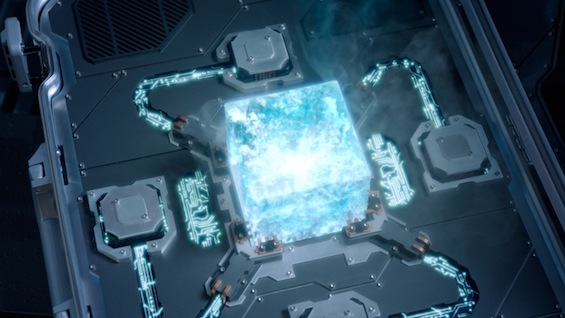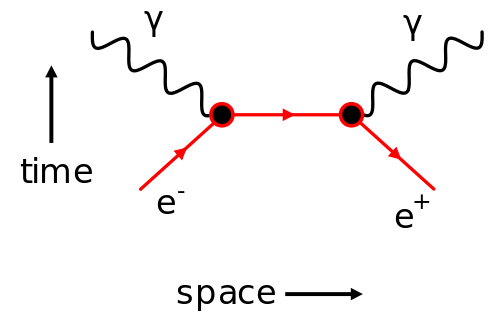Copernicus here. Longtime fans of AICN know that in addition to writing film reviews, I occasionally write articles about the science of movies. That’s because my not-so secret alter-ego is that of a professional astronomer at Las Cumbres Observatory and professor of astrophysics at University of California, Santa Barbara. I really care about how science is portrayed in movies, because scientific literacy is important to society, and for many of the students in my classes, their primary exposure to science is through the news and pop culture.
When I was younger I read all kinds of Marvel comics, including the Avengers, West Coast Avengers, Iron Man, Thor, etc. So I was just crazy-excited to see them on the big screen. And the result exceeded my expectations. Whedon knocked it out of the park, nailing the characters and delivering some of the best action scenes I’ve ever seen. But just as much credit is due to Kevin Feige, who has overseen the careful construction of a Marvel cinematic universe where it everything has been building to this. Superpowers have been handled with enough of a consistent and scientific tone that it isn’t jarring to see Thor and the same film with the technologically more grounded Iron Man.

Part of my goal in reviewing the science of THE AVENGERS is to point out all kinds of Easter eggs that the filmmakers threw in that keep the movie scientifically grounded. The point isn’t to nitpick over whether every little thing really could have happened. Obviously, in a movie about thunder gods and giant green monsters, we’re going to have to suspend our disbelief. Things like superpowers that were established in comic books are grandfathered in, in terms of plausibility. But it is still sometimes worth looking at the physics of some things in the film just to use it as a jumping-off point to teach some science. And even if you have to bend the rules underlying our universe to get some cool superheroes, and occasionally advance the plot, that’s fine with me. But if you get some science wrong for no good reason, that’s just lazy storytelling and it takes me right out of a film. In many films, with a little deeper understanding, the filmmakers could have done something even more spectacular.
This review got so long that I’ve had to split it into two parts. Here in part 1, I’ll cover the plot and technology in THE AVENGERS. In part 2, I cover the characters. There will be spoilers!
Dark Energy
Dark Energy gets a couple of nods in THE AVENGERS. Now this I know something about! I’ve spent many years of my life trying to figure this stuff out. Last year, my old boss, Saul Perlmutter, and two friends and colleagues of mine, Brian Schmidt and Adam Riess, were awarded the Nobel Prize in physics for the discovery of the accelerating universe -- effectively for the discovery of Dark Energy. This was really the work of two teams, Perlmutter’s Supernova Cosmology Project (the one I joined in 2000), and Schmidt and Riess’ High-z Supernova Search team. And now, my most recent group, the Supernova Legacy Survey has the best measurements of the properties of the Dark Energy. I wrote a review paper on the subject for one of the Nature journals, which you can find here.
Right off the bat in THE AVENGERS, we are introduced to a facility called the Joint Dark Energy Mission. Ha! That’s a nod to a satellite concept many of my colleagues have spent years of their life developing. It is called Joint because it was a combined effort between NASA and the US Department of Energy. The idea was to use supernovae, weak lensing (the way galaxies distort light like a magnifying glass), and baryon acoustic oscillations (the imprint sound waves left on the early universe), to measure Dark Energy. I even wrote a white paper, with my colleagues from all over the world, arguing the need for such a mission to the panel reviewing all of astrophysics for 2010-2020. As a part of that review process, JDEM was selected as the top priority space mission for this decade in astrophysics, but it was redesigned into something called wFIRST. Since astronomers have effectively stopped using the JDEM name, I suppose the filmmakers thought that would make a good name for the institute where Dark Energy is being studied.
That was very cool to see, but then at the JDEM institute in THE AVENGERS they had tons of radio dishes! We don’t use radio telescopes to study Dark Energy. And they were too close to the building -- we’d never put our sensitive electronics that close to tons of people with cell phones, wifi, etc., because of the interference. Observatories are usually out in the middle of nowhere, while the offices full of astronomers are in bigger cities (to attract the best talent). Still, I know why the filmmakers did it. When the whole complex starts to cave in, watching a field of radio telescopes go down is a lot more fun than a couple of telescope domes. But anything that causes an expert to roll their eyes just isn’t worth such a minor storytelling gain in my book. You want the experts geeking out, not groaning.
Dark Energy shows up again when Loki says to Thor something like, “The allfather must have had to expend a great deal of Dark Energy to get you here.” This refers to the fact that Dark Energy makes up about 74% of the mass-energy density of the universe, with Dark Matter making up about 22%, and normal matter, including basically everything you’ve ever heard of -- planets, stars, galaxies, Hot Pockets, etc. -- making up only 4%. We barely know what Dark Energy is, but apparently the more scientifically advanced Asgardians know a lot more about it, and can even manipulate it. The normal way Asgardians travel between realms, the wormhole-generating Bifrost, was destroyed in THOR. So that one-liner is a way of saying that Odin can still teleport Thor places, but at great cost. This explains why he hasn’t just used it to do some hammer time with Jane Foster.
But what is Dark Energy, and can you turn it into regular energy? To figure out what Dark Energy is, we make a map of the history of the expansion of the universe using supernovae to measure distances. If we rewind the expansion of the universe, in the early universe everything was closer together, so the gravitational attraction due to matter (both regular and dark) was more important. But as the universe expands, the amount of matter stays the same, but the volume of space goes up. So the density of matter in the universe is always falling. Strangely, Dark Energy doesn’t behave that way. Our group’s latest measurements show that the amount of Dark Energy in the universe increases over time, keeping pace with the expansion of the universe. Double the volume of the universe, and you double the amount of Dark Energy. That’s weird stuff! But the density of Dark Energy (the amount per volume) stays the same, in stark contrast to the behavior of matter. This means that the Dark Energy is probably a property of the vacuum of space itself. There’s actually no reason that the lowest energy quantum mechanical state of the vacuum has to be zero. However, as far as we know, tapping into this zero point energy is impossible.
But maybe the Asgardians know something we don’t. If we could extract Dark Energy from the vacuum, how much would we get? In one cubic meter of space, the amount of Dark Energy is very low -- equivalent to the energy in a few atoms of hydrogen. But on Earth, in that same volume, there are 1025 molecules of oxygen and nitrogen! That’s one with 25 zeroes. So here normal energy dominates over Dark Energy by a factor of 10 septillion or so. That’s why you don’t feel the effects of Dark Energy on Earth -- you can only feel its effect over enormous distances, where all those septillions of cubic meters add up. And you really need to get outside of galaxies, to the unimaginable voids between them, before Dark Energy starts summing up to something serious. Inside galaxies, gravity dominates over Dark Energy by a large margin. So my problem with Asgardians being able to tap into Dark Energy is not just that by all known physics it is impossible, it is that to get enough they’d have to be masters of intergalactic distances. That just makes them too powerful.
Verdict: Cool points for mentioning Dark Energy, because I get to talk about it. But have another throwaway energy source for Odin. And leave out the radio telescopes.
The Tesseract
It was awesome to see the Tesseract, aka the Cosmic Cube from the comics, show up as a MacGuffin in CAPTAIN AMERICA, in Howard Stark’s drawings in IRON MAN 2, in the post-credits sequence of THOR, and then be carried over as a major element of the plot in THE AVENGERS. In geometry, a tesseract is a four-dimensional hypercube. In the Marvel universe, the Cosmic Cubes (since there are now more than one), have had a long and crazy history, with powers ranging from warping reality to granting wishes. In THE AVENGERS it is mainly used as a source of energy and to open portals, but there are hints that something larger is going on.

To activate the Tesseract, there is line of dialogue about how the secret was heating it to (if I remember correctly) 100+ million Kelvin to “overcome the Coulomb barrier.” The Coulomb barrier is the electrostatic repulsion any two atomic nuclei have that keep them apart. You have to have enough energy to overcome this to force to get nuclei close enough together that the much more powerful (but short-ranged) strong force takes over, allowing a nuclear reaction like fusion. “Kelvin” is a measure of temperature (effectively equal to Celsius at these temperatures). Since temperature is a measure of the speed of a group of particles, a higher temperature means faster-moving, more energetic particles, fast enough to overcome the Coulomb barrier and slam together nuclei. So it sounds like the Tesseract is doing fusion! That was a nice bit of background in a throwaway line.
Except there’s one problem. The core of the Sun is 16 million Kelvin. A hundred million Kelvin would be insane to produce on Earth. For the TV show I co-hosted, Known Universe, I calculated what would happen if you put a piece of the core of the Sun the size of a suitcase in downtown LA. You can see my calculations here. Basically, it would be very similar to a nuclear bomb, and destroy the city. The Tesseract is smaller than a suitcase, but has a higher temperature, so the result would be pretty much the same. I guess it can somehow contain that temperature internally without exposing us to it.
They say the Tesseract emits gamma rays -- this makes sense! Gamma rays are like X-rays, only shorter wavelength, and thus more energetic. In fact, they are the highest energy radiation on the electromagnetic spectrum. Everything emits radiation with the wavelength of the radiation inversely proportional to the object’s temperature. So the higher the temperature, the shorter wavelength radiation it emits. The Sun is about 10,000 degrees F at the surface, so it emits light in the visible part of the spectrum (in fact our eyes evolved to sense sunlight). More luminous stars emit primarily in the shorter-wavelength ultraviolet part of the spectrum. People are 98.6 deg F, so we emit light in the longer-wavelength infrared. That’s why when you turn off the lights people don’t glow in visible light, but they do glow in the IR. The tesseract has a phenomenal energy, so it would glow in gamma rays.
But if Banner is such a gamma-ray expert, he shouldn’t have told SHIELD to tell anyone with a spectrometer to put it on the roof to locate the Tesseract. Laboratory spectrometers won’t do shit for locating distant gamma rays. And no astronomers have gamma-ray spectrographs on Earth, because the atmosphere blocks gamma rays. We have to use satellites to look for them. In fact, the first cosmic gamma ray bursts were discovered by the military’s Vela satellites in 1967. They were looking for the gamma ray signatures of nuclear explosions on Earth which might be violating the 1963 Partial Nuclear Test-ban treaty. Today, how does the US pinpoint rogue nuclear explosions? Let’s just say that the GPS satellites do a lot more than locate your position. Banner should have told SHIELD to locate the cosmic cube with the X-ray detectors on GPS satellites. Anything that puts out gamma rays, puts out X-rays too.
Finally, there are hints in the movie that the Tesseract has a mind of its own. It won’t let humans shut it down. The characters under its influence say it revealed things to them. In the comics, at least once, the character of the Beyonder (effectively God), is said to be a Cosmic Cube that achieved sentience. It sounds absurd that an inanimate object could start thinking. But is it? After all, humans are in a way the consciousness of stars. We are made up of stuff created inside stars, but gathered back together in such a way that we have achieved sentience. We are a way for the universe to contemplate itself.
And as much as the 12 year old in me wants to see the Beyonder in a future movie, I’m sure that’s not where they’re going. God is a lame antagonist -- see Star Trek 5. And he just doesn’t fit into the Marvel movie universe.
Verdict: Pretty awesome!
The Helicarrier
In the film, some of our heroes arrive on a seemingly nondescript aircraft carrier. But as any fan of the comics knows, SHIELD’s base of operations doesn’t just float -- it can fly. As a Marvel fan, I loved seeing the Helicarrier realized on-screen, and its dramatic rise out of the ocean brought a little bit of wonder to what could have been just a boring set. But could we ever do this?

First, how much energy would it take to lift an aircraft carrier to the height of, say, a kilometer? From high school physics you might remember that the equation for potential energy is U=mgh, where m is mass, g is acceleration due to gravity (9.8 m/s2), and h is height. I’m not sure how much a Helicarrier weights, but a Nimitz-class aircraft carrier (which the movie Helicarrier was modeled on) weighs about 100,000 tons fully loaded, or 108 kg. Plugging in the numbers, we find that it would take about a trillion joules of energy to lift one a kilometer. Nimitz-class aircraft carriers are nuclear-powered, so that they can go for 20 years without refueling. Their reactors generate about 200 megawatts at peak output. Since a watt is a joule per second, we can divide a trillion joules by 200 million joules per second to find that it would take an aircraft carrier about 5000 seconds to generate enough energy to lift it a kilometer, assuming it was using all of its energy to do that. Being able to stay hovering is another thing, but hey, that’s in the ballpark. Maybe the Helicarrier has more powerful reactors, is much lighter, or they’ve figured out how to get energy out of the Tesseract. On energetics, I give them a pass.
But the four engines of the Helicarrier look like pretty simple ducted fans. Could they generate enough thrust to lift it? Could anything? Thrust is a force. To make the carrier hover, we need to generate enough thrust to balance the force of gravity. We can calculate this from Newton’s second law: F=ma, where F is a force, m is mass, and a is acceleration. Here we use the acceleration due to gravity again, which is what we have to counterbalance. Plugging in the numbers, we get that we need a force (thrust) of about a billion Newtons. The world’s most powerful commercial jet engine (a turbofan, which is slightly different in design, but close enough), the GE90-115B on some versions of the Boeing 777, generates 569 kilo-Newtons of thrust. So would take a hell of a lot more than 4 of them to levitate an aircraft carrier -- you’d need about 1700 such engines. If you were using the Space Shuttle Solid Rocket Boosters instead, you’d still need about 70 of them. This makes sense -- an aircraft carrier is about 50 times heavier than a Space Shuttle.
So modern engines aren’t able to lift an aircraft carrier. But in the Marvel universe they’ve got crazy materials like adamantium and vibranium. Maybe their engines are way better. The filmmakers had a choice -- they could have added a ton of engines to make the Helicarrier slightly more realistic to a few physicist nerds, or they could keep the classic design of the comics to appease the legions of comic book geeks. I think they made a wise choice! Besides, a lot of the drama depends on restarting one of the failed engines. That worked fairly well, if it did reek of the dreaded Whedon bespoke deathtrap (see Serenity).
Verdict: Minor science stretching for good storytelling is exactly what you should do as a writer.
Iron Strangelove
The climax of THE AVENGERS hinges on Iron Man having to dispose of a nuclear missile that he is told will detonate in one minute. The Black Widow holds off on closing a portal leaking aliens so that Iron Man can personally escort a missile through it. This is where THE AVENGERS fell a little flat for me -- everything about this felt scripted.
The main problem is that timers aren’t the way air-to-surface nuclear missiles are detonated. I’m sure the exact manner is classified, but from the basic physics it isn’t that hard to figure out how it has to be done. Nuclear weapons generally aren’t triggered when they hit a target, they are detonated above a target in an airburst. This produces the most damage over the widest area. If you used a timer you’d have to know when the pilot was going to launch the missile, his position, the time it would take to get to its target, atmospheric conditions, etc. Instead you want to trigger the detonation when the missile reaches a specific height above the ground, and the best way to do that is to use either an altimeter, GPS, or a proximity fuze. Proximity fuzes have a fascinating history -- the British invented the first one during WWII, and it changed the course of the war. They used the Doppler shift (the change in pitch you notice from a moving siren or train) to trigger an explosion as they approached a target. Since you could now hit a moving target, it allowed them to shoot down the V-1s that were bombing London with a much higher success rate, it severely crippled the effectiveness of Japanese Kamikaze attacks, and it helped the allies win the Battle of the Bulge. All from basic physics!
I’m fine with the whole idea of the nuclear missile -- it served several purposes. It provided drama, a chance for Tony Stark to be a hero, and it wrapped up the battle with a bang. But shoehorning it in to the time bomb trope was unnecessary and took me out of the film. The missile provided enough drama. It could have detonated on contact with (or proximity to) the alien ship. Besides, we all knew there was going to be an Iron Man 3, so drama about whether or not he was going to die was just ineffective.
Verdict: Annoying to me, but not that bad in the scheme of things. I just like to bitch.
Minor technobabble
There are a few points in the script where some scientific sounding jargon is thrown around. One of the earliest bits of incidental science background concerns Loki’s quest for iridium. As they correctly explain in the film, iridium is used in the creation of antiprotons. You shoot protons at a target made of iridium, and sometimes you get out antiprotons -- effectively antimatter. That’s a nice little detail, thrown in for all the particle physicists out there. What’s more, iridium is quite rare in the Earth’s crust, because it is so heavy it sank to the core of the Earth when it was molten. It’s actually not that rare in asteroids, which weren’t big enough to be melt. That’s why there is a layer of iridium all over the Earth in the layers of rock that are 65 million years old, at what is called the K-T boundary. It is from the asteroid impacts that killed most of the dinosaurs.
Iridium is one of the rarest elements on Earth, ten times rarer than platinum. Even so, you don’t need to raid Stuttgart to get it -- you can just buy it for about $600 a troy ounce. Or since Asgardians are a spacefaring people, I’m sure it is much cheaper for them -- Loki should have just brought some from home. Ahh, but when did supervillains ever eschew flamboyance for practicality? Besides, a big part of Loki’s plan was apparently to get captured.
So much for antiprotons. Antielectrons also show up in THE AVENGERS. When Tony Stark first meets Bruce Banner, he says says something like, “I enjoyed your theory on antielectron annihilation.” There’s one problem with that -- physicists would almost always say “positron,” not “antielectron.” Also, the annihilation of a positron occurs when it meets its antimatter particle, a normal electron. So it would be equivalent to talk about his theory of “electron annihilation.” Still, none of what Tony Stark says is wrong, just a little strange. Interestingly enough, that process does give off a gamma ray -- something Banner is an expert at. Maybe that was an insanely subtle physics joke.

Verdict: I love it when throwaway lines have extra meaning the more you know.
All in all, the physics of the hardware in the Avengers was pretty good. I’m impressed! But what about the characters, and the portrayal of scientists? That will have to wait until part 2!
- Copernicus (aka Andy Howell).
Send me a nasty-gram.
Follow me on Twitter
